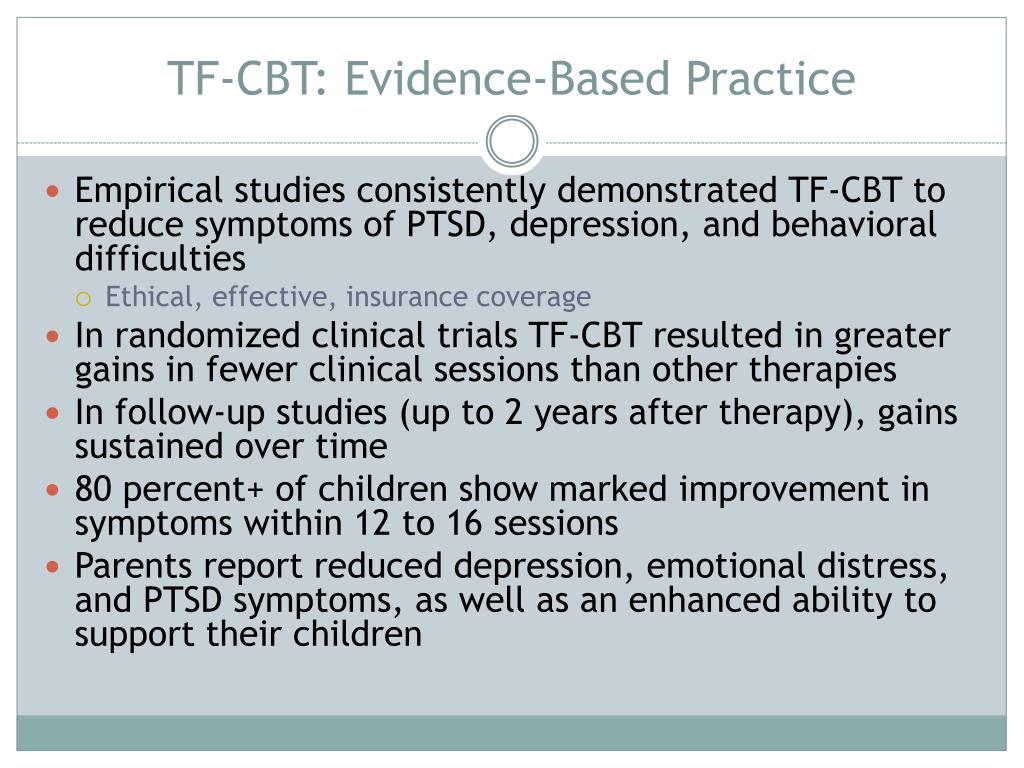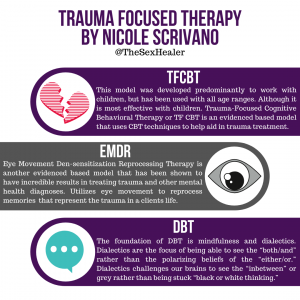
This provides the parent with an opportunity to use the skills she/he learned during conjoint therapy. Finally, the child shares the story with the parent, allowing the parent to completely understand the child’s perspective. The therapist uses careful interventions to help the child build tolerance. The child creates a story, which is first shared with the therapist. Trauma focused-CBT has a narrative component that is critical to its success. TF-CBT uses a structured, three-phase format. It is important to note that only a non-offending parent can be part of the treatment. It includes psychoeducation for the parent while teaching new skills, including effective parenting, stress-management, and communication. An essential part of TF-CBT is providing equal time to the parent. All materials use age-appropriate language, skills building and examples.

Source: APA Div.An offshoot of typical cognitive behavioral therapy, trauma focused-CBT techniques help children modify negative, unhelpful thoughts, emotions and behaviors that result from childhood traumatic experiences. A certain amount of information about one’s history is needed, but the focus is primarily on moving forward in time to develop more effective ways of coping with life. Through exercises in the session as well as “homework” exercises outside of sessions, patients/clients are helped to develop coping skills, whereby they can learn to change their own thinking, problematic emotions, and behavior.ĬBT therapists emphasize what is going on in the person’s current life, rather than what has led up to their difficulties. Rather, the psychologist and patient/client work together, in a collaborative fashion, to develop an understanding of the problem and to develop a treatment strategy.ĬBT places an emphasis on helping individuals learn to be their own therapists. Not all CBT will use all of these strategies. Learning to calm one’s mind and relax one’s body.Using role playing to prepare for potentially problematic interactions with others.Facing one’s fears instead of avoiding them.Learning to develop a greater sense of confidence in one’s own abilities.ĬBT treatment also usually involves efforts to change behavioral patterns.Using problem-solving skills to cope with difficult situations.Gaining a better understanding of the behavior and motivation of others.Learning to recognize one’s distortions in thinking that are creating problems, and then to reevaluate them in light of reality.People suffering from psychological problems can learn better ways of coping with them, thereby relieving their symptoms and becoming more effective in their lives.ĬBT treatment usually involves efforts to change thinking patterns.


Psychological problems are based, in part, on learned patterns of unhelpful behavior.Psychological problems are based, in part, on faulty or unhelpful ways of thinking.In this manner, CBT differs from many other forms of psychological treatment.ĬBT is based on several core principles, including:

Indeed, CBT is an approach for which there is ample scientific evidence that the methods that have been developed actually produce change. It is important to emphasize that advances in CBT have been made on the basis of both research and clinical practice. In many studies, CBT has been demonstrated to be as effective as, or more effective than, other forms of psychological therapy or psychiatric medications. Numerous research studies suggest that CBT leads to significant improvement in functioning and quality of life. Cognitive behavioral therapy (CBT) is a form of psychological treatment that has been demonstrated to be effective for a range of problems including depression, anxiety disorders, alcohol and drug use problems, marital problems, eating disorders, and severe mental illness.


 0 kommentar(er)
0 kommentar(er)
